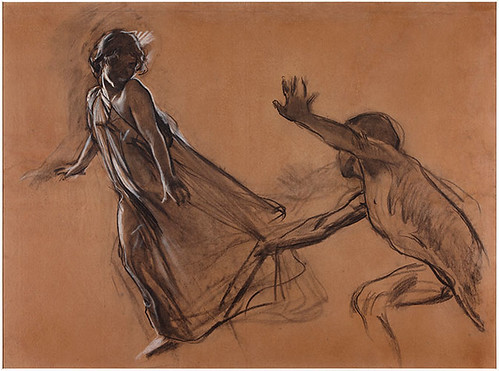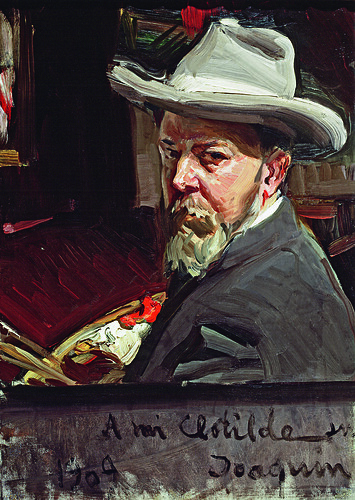Texas Sorolla Exhibition Makes History
The first portrait ever painted of William Howard Taft, 27th president of the United States, was painted by Spanish artist Joaquin Sorolla y Bastida. The artist painted the portrait during his first groundbreaking exhibition at The Hispanic Society of America in New York in 1909.
More than 100 years after Sorolla took America by storm, with additional exhibitions in Buffalo and Boston, the Meadows Museum in Dallas is making history with a Sorolla and America exhibition.
“This is the first exhibition to study this important Spanish artist; it’s an exhibition we felt was needed,” said Mark A. Roglan, Ph.D. Dr. Roglan is the Linda P. and William A. Custard Meadows Museum Director and the Meadows School of the Arts Centennial Chair.
The largest and most comprehensive exhibition of Sorolla ever assembled runs through April 19, 2014 at the museum. It showcases some 160 works of art by Spain’s most famous modernist artist. In fact, more than 40 of the artworks have never been on public display before.
Museum attendees may be surprised to learn that Joaquin Sorolla y Bastida was the best known Spanish artist in the world before Pablo Picasso came on the art scene. Sorolla, who was an admirer of Spanish painter Diego Velazquez, was a master of light who preferred to paint outdoors.

Joaquín SOROLLA y Bastida (1863–1923) The Blind Man of Toledo (El ciego de Toledo), 1906 Oil on canvas (óleo sobre lienzo) Museum Purchase; Meadows Foundation Funds with private donations, 03.01
Except for those owned by the museum, most of the artworks in the exhibition are on loan from private collectors and public institutions. For example, Taft’s portrait is on loan from the Taft Museum of Art in Cincinnati. Taft’s portrait is one of 29 painted by Sorolla during his first American exhibition in 1909.
The Meadows Museum is a leader in the study and presentation of artworks from Spain. Its vast collection includes works by Velasquez, Murillo, Goya, Picasso, El Greco, Miro, Sorolla, and many others. The museum’s collection of Spanish art is second only to the Prado Museum in Madrid.
Algur H. Meadows, a Texas oilman, philanthropist and Spanish art collector, dreamed of starting his own “Prado on the Prairie” after being inspired by artworks he saw at the Prado. In 1962, he donated his art collection and funds to Southern Methodist University to start the museum. His dream of having a Prado in Dallas became a reality in 1965 when the museum opened to the public.
Today, the Meadows Museum has amassed a collection of Spanish artworks that spans from the 10th to the 21st century. For the Sorolla and America exhibition, the museum is partnering with the San Diego Museum of Art and Spain’s FUNDACIÓN MAPFRE, a cultural institution, to host the exhibition.
“It’s possible to go to almost any museum in the United States and see Sorolla’s work. The Hispanic Society of America is Sorolla’s home in the U.S. The Meadows Museum is uniquely well suited to present the first exhibition examining the reciprocal influence Sorolla had on America and America had on Sorolla,” he added.
More than 50 different institutions have loaned Sorolla’s artworks for this exhibition. They include: The Metropolitan Museum of Art; the J. Paul Getty Museum; The Museum of Fine Arts Boston; The Philadelphia Museum of Art; The Art Institute of Chicago; and the San Carlos National Museum in Mexico City.
The Hispanic Society of America and Museo Sorolla in Madrid have provided archival material in addition to numerous artworks. The U.S. Department of State has loaned its private collection as well.
San Diego Museum of Art is the next venue for the exhibition, which concludes with a final stop at Fundacion MAPFRE in Madrid. The exhibition is made possible due to a generous gift from the Meadows Foundation and the support of Hispanic Society of America.

Joaquín Sorolla y Bastida (Spanish, 1863-1923), Portrait of Louis Comfort Tiffany, 1911, oil on canvas. The Hispanic Society of America, A3182
In addition to the mural-sized paintings, the exhibit features oil sketches, drawings, and gouache. Sorolla was fond of sketching and drawing on the backs of menus while in New York and Chicago, so viewing these items provides visitors with more of an understanding of the artist.

Joaquín Sorolla y Bastida (1863–1923), Girl and Boy Playing, 1908, charcoal and chalk on paper. Private Collection. Photo by Joaquín Cortés
Many of Sorolla’s paintings were purchased by private collectors. That is why some 100 have not been seen publicly since 1909 and 1911. The artist’s great-granddaughter and the exhibition’s curator, Blanca Pons-Sorolla, has worked diligently for decades to locate many of the paintings.
“I have worked on this project for many years, and there are still approximately 200 paintings by my great grandfather that have not yet been located,” she said at a recent press preview at the Meadows.
Paintings and artworks exhibited more than a century ago, in 1909 and then in 1911, will be reunited for the first time in this monographic exhibition, which is a colossal tribute to Spain’s foremost modernist artists.

Joaquín Sorolla y Bastida (Spanish, 1863-1923), Self-Portrait, 1909, oil on canvas. Madrid, Museo Sorolla, 840
Joaquin Sorolla y Bastida was born in Valencia in 1863. He and his only sibling, Concha, were orphaned in 1865 after their parents died, possibly from cholera. Sorolla and his sister were reared by their maternal aunt and her husband. At 22, after mandatory service in Spain’s military, Sorolla received a grant enabling him to study painting in Rome.
In 1888, Sorolla returned to Valencia and married Clotilde Garcia del Castillo. The couple had three children. His family, especially his wife, became popular subjects of his art. In 1890, Sorolla moved his family to Madrid, where he spent the next decade painting large canvases depicting historic, social, and mythological subjects.
Sorolla’s first taste of international success as a painter came in 1892 with a striking painting titled Otra Margarita! or Another Marguerite! Social realism, one of his topics, is depicted in the painting of a woman accused of suffocating her child. The National Exhibition in Madrid awarded this painting a Gold Medal.

Joaquín Sorolla y Bastida (Spanish, 1863-1923), Another Marguerite!, 1892, oil on canvas. Mildred Lane Kemper Art Museum, Washington University in St. Louis. Gift of Charles Nagel, Sr., 1894. WU 2930
In 1893, the painting earned a Medal of Honor at Chicago’s World’s Columbian Exposition. In fact, Otra Margarita! was purchased and donated to Washington University in St. Louis, Missouri. It was the first painting by Sorolla to hang in an American museum. The museum is now the Mildred Lane Kemper Art Museum.
Another turning point in Sorolla’s career came in 1899 with a painting depicting disabled children enjoying a day at the beach while supervised by a monk. Titled Triste Herencia or Sad Inheritence, the painting earned the highest awards at the Universal Exhibition in Paris in 1900 and at Spain’s National Exhibition in 1901.

Joaquín Sorolla y Bastida (Spanish, 1863-1923), Sad Inheritance!, 1899, oil on canvas. Bancaja Collection, Valencia
The two iconic paintings set the stage for Sorolla’s introduction to two wealthy American patrons, Archer Milton Huntington and Thomas Fortune Ryan. Huntington and Ryan would be the catalysts for his first and second exhibitions in America.
Huntington, who founded The Hispanic Society of America for the diffusion of Spanish art and literature, discovered Sorolla at a London exhibition in 1908. He was so impressed with Sorolla’s work that he arranged for his first American exhibition at The Hispanic Society of America in New York.
During its month long run, the exhibition attracted more than 150,000 people despite bone-chilling weather. The New York Herald reported that “hundreds, perhaps thousands, of visitors were turned away.” The exhibition enjoyed similar success during its run in Buffalo and Boston.
With 150 of the 356 artworks sold during the New York run, Huntington persuaded Sorolla to return for a second exhibition. So in 1911, another American exhibition of Sorolla’s work was held at the Art Institute of Chicago and subsequently at the City Art Museum in St. Louis, Missouri.

Joaquín Sorolla y Bastida (Spanish, 1863-1923), Walk on the Beach.
This second exhibition included his familiar works as well as a “Vision of Spain” series proposed by Huntington for The Hispanic Society of America facility. The request and subsequent contract with Huntington prompted Sorolla to visit unfamiliar regions of Spain. (The "Visions of Spain" murals are not actually in the show, as they were too large to travel from The HAS.)
The result of Sorolla’s travels through Spain was a monumental collection of 14 canvas murals highlighting the natural beauty of several Spanish regions. Sorolla painted his subjects in costumes reflecting their culture and heritage. His artworks captured the essence of Spain and resulted in public display at the New York headquarters of The Hispanic Society of America.

Joaquín Sorolla y Bastida (Spanish, 1863-1923), The death of Pedro Velarde y Santillán during the defence of the Monteleon Artillery Barracks. Biblioteca Museu Víctor Balaguer
In 1909 while Ryan was in Paris, he commissioned Sorolla to paint Christopher Columbus. Sorolla researched the life of the famous explorer before settling on Christopher Columbus Leaving Palos, Spain, the final painting. It depicts a balding, gray-haired Columbus looking out from his boat. The painting is on loan from the Mariners’ Museum in Newport News, Virginia, for the exhibition.
Sorolla’s American contemporaries, John Singer Sargent (1856-1925) and William Merritt Chase (1849-1916), also played a role in his success in America. That said, the focus of the exhibition is Sorolla’s influence on America, and America’s influence on him.
Sorolla was internationally recognized for his beach scenes, landscapes, and portraits prior to his first exhibition in America. In 1900, he won a Medal of Honor at the Paris Universal Exposition and a Knight of the Legion of Honor nomination. In 1901, Sorolla won a Medal of Honor from the National Exhibition in Madrid. He was an honorary member of the Fine Arts Academy of Paris, Lisbon, and Valencia.

Joaquín Sorolla y Bastida (Spanish, 1863-1923), Lighthouse Walk at Biarritz, 1906, oil on canvas. Museum of Fine Arts, Boston. Peter Chardon Brooks Memorial Collection; Gift of Mrs. Richard M. Saltonstall, 22.691. Photography © Museum of Fine Arts, Boston
Over his lifetime, Sorolla produced some 4,000 works of art. While Sorolla was a prolific artist, when he completed work on Huntington’s Vision of Spain in 1919, he was exhausted. In 1920, the artist, whose home and studio is now the Sorolla Museum in Madrid, suffered a stroke while painting in his beloved garden. The stroke left him paralyzed until his death in 1923.
The exhibition has an accompanying 320-page catalogue published by Ediciones El Viso. It includes a complete list of all works exhibited, created and sold in America during Sorolla’s lifetime, including reproductions of works yet to be located.
The Meadows Museum will celebrate its 50th anniversary in 2015. So it plans to hold special exhibitions and programs to celebrate. That said, the Sorolla and America International Symposium is set for Feb. 8, 2014.
The “Sorolla and America” exhibition and symposium is expected to draw art lovers from across the country. Call: 214 768-2516 or go to: www.meadowsmuseumdallas.org for museum hours and ticket information.
Feature photo: Joaquín Sorolla y Bastida (Spanish, 1863-1923), The Three Sails.
-

- Log in to post comments




















